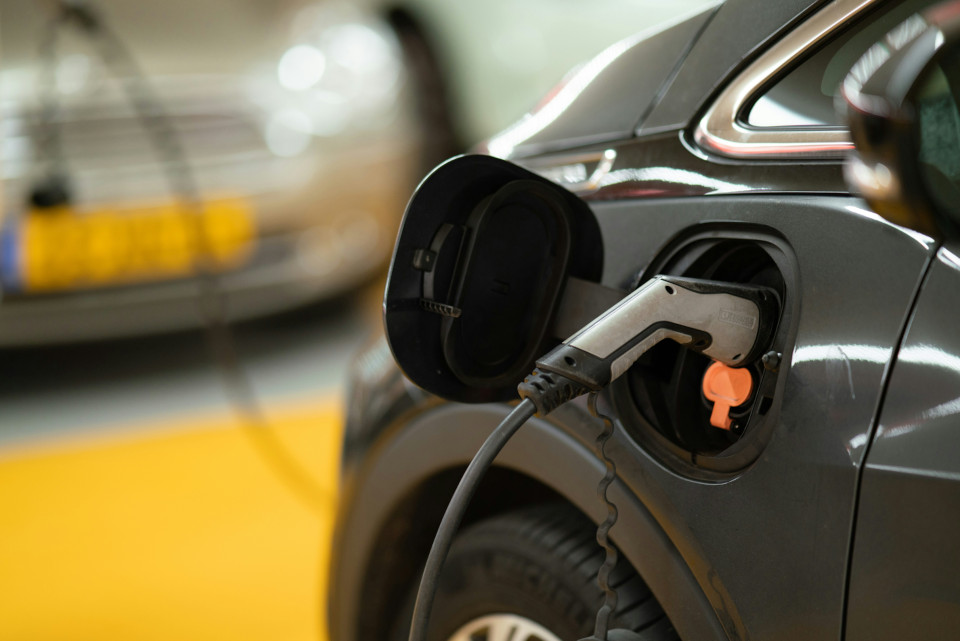EV Charging Money Stalled
Air Date: Week of March 28, 2025

Tesla’s Supercharger network is already one of the most robust in the country, giving the company a significant head start—so while the pause in federal EV charging funds stalls other networks, Tesla is unlikely to be heavily impacted. (Photo: Ewan Streit on Unsplash)
Electric vehicle chargers are still few and far between compared to gas stations, and a program funded by the 2021 bipartisan Infrastructure Law sought to install many more. But now the Trump administration has stalled this funding for EV chargers. Lee Hedgepeth of Inside Climate News speaks with Host Jenni Doering about the political nuance of the pause.
Transcript
CURWOOD: From PRX and the Jennifer and Ted Stanley Studios at the University of Massachusetts Boston, this is Living on Earth. I’m Steve Curwood.
DOERING: And I’m Jenni Doering.
Electric cars are generally much cheaper to run than gas or diesel ones, saving money as well as lives. It costs about three dollars to take a gas sedan 30 miles, but only about a dollar’s worth of electricity to power an EV sedan the same distance. And the American Lung Association estimates that shifting to 100% sales of zero-emission vehicles in the US over the next 30 years would save more than 100,000 lives and nearly a trillion dollars in health costs linked to air pollution. But the adoption of EVs is going slowly in the US, as potential EV drivers worry about getting stranded, as chargers are still few and far between, compared to gas stations. The answer is more chargers, hundreds of thousands of them, placed along major interstates, rural highways, and city streets, and the National Electric Vehicle Infrastructure or NEVI program helps pay for building them. But now the Trump Administration has stalled this funding for EV chargers. Lee Hedgepeth of our media partner, Inside Climate News has been reporting on this and he joins us now from Alabama. Hey, Lee, welcome to Living on Earth!
HEDGEPETH: Thank you. Thank you for having me.
DOERING: So, what is the National Electric Vehicle Infrastructure or NEVI program?
HEDGEPETH: So, NEVI Program is a program that was created by the bipartisan infrastructure law that was passed in 2021 and it's a program where the federal government is laying out a lot of dollars to help local governments, mostly state governments, in this case, to pay for and help subsidize electric vehicle chargers along major highways and interstates across the country.
DOERING: And so what is it that the Trump administration is trying to do with this program?
HEDGEPETH: So essentially, the Trump administration has paused all funding related to the program, first with an executive order that was issued by the Trump administration on day one, and then, with other guidance that was issued later by the Department of Transportation. They essentially told states these plans that you've submitted about how you plan to spend money that we're giving you through NEVI are invalid, and we'll give you other guidance later that will allow you to submit different plans, and we'll issue money later, once those plans are approved. But we still haven't seen those guidelines come out. So, as of now, all of this funding has essentially been paused across the country.

Combustion vehicles are a major source of air pollution and greenhouse gas emissions, which electric vehicles aim to reduce. Delays in building a nationwide charging network are expected to slow down the transition to cleaner transportation. (Photo: Denys Nevozhai on Unsplash)
DOERING: And what does the Trump administration's efforts to pause this funding for EV charging mean for the states receiving these funds?
HEDGEPETH: So, different states have reacted to this new guidance in different ways. So some states like Alabama have completely paused their programs, and other states, more liberal states with democratic governments, have said, we're going to fill in the gaps when it comes to these funds being paused. So here in Alabama, for example, there were 12 or 13 chargers that were being funded, mostly at truck stops across the states. Those funds have been paused, and the state government has really made no effort to fill in those gaps. So you're seeing different reactions from different states, but basically, what it's leading to is just a delay in getting these electric vehicle chargers built across the country in places where they're needed.
DOERING: Now, I know that when NEVI was implemented, the Biden administration set a target for at least 500,000 new publicly available chargers by 2030. How much progress had the US made towards that goal before this funding pause?
HEDGEPETH: Not a lot of progress. So, the rollout had been fairly slow, and that was something that folks on both sides of the aisle had criticized. So, I think until maybe 2023, 2024, during that period, they had only rolled out about a little over 100 chargers funded through the NEVI program, which is not a lot compared to the goals that the Biden administration had set out. And so you saw a lot of pushback from environmental groups who wanted this money to be rolled out quicker, not just because they wanted to see the electric vehicle charger infrastructure be better, but also because they were anticipating this potential rollback, which eventually happened under the Trump administration. So, there was definitely not as much progress as the Biden administration had hoped and that environmental groups had hoped in terms of rolling this out, and then obviously Trump throwing a wrench into this program is not going to help move this program along in any way.
DOERING: By the way, you mentioned that some of the more liberal blue states are saying they're committed to providing funding for these chargers, even if the federal government is stepping back. How does that funding compare to the federal funding?
HEDGEPETH: So, some states, including states like Alabama, do have electric vehicle charging programs, but that funding is just not anywhere as much as what we saw from the NEVI program. So in Alabama, for example, we were slated to receive about $79 million from the NEVI program during the five year period that that money was being expended, and during the same period, there was something like three or $4 million that the state had used in their kind of state level program. So it's not a lot, comparatively. Even in liberal states, state revenues in these individual states just aren't comparable to the the amount of money that Congress is willing to spend and did allocate through the infrastructure bill.

Electric vehicles produce zero tailpipe emissions and are a key tool in the fight against climate change. Building a reliable charging network is essential to ease range anxiety and encourage wider adoption across the U.S. (Photo: Michael Foursert on Unsplash)
DOERING: Lee, I think in your article, you wrote about how the Republican governor of Alabama came out in support of EVs. What has she said? And why is that?
HEDGEPETH: One of the things that governors like Kay Ivey here in Alabama like to tout is new jobs, for example. Governors in other Republican states will tout these types of spending on electric vehicle chargers, and also on the production of electric vehicles themselves. So you see companies like Kia and Hyundai, for example, that have factories in Alabama. And so when politicians are able to kind of tout those types of investments in the state, those are things that they you know, will go to the ribbon cuttings for, for example. There's also the dynamic of the people who are receiving these funds. So the NEVI funds, for example, and a lot of the funds that the state give out are going to private entities that have traditionally been donors to more conservative politicians. So in Alabama, many of the chargers that were going to be funded through the NEVI program were at Love's truck stops, which, obviously they're invested in fossil fuel extraction as well, in terms of they have many, many gas pumps across the state. And so, you know, one dynamic that's happening is you'll see companies like that, when we reached out to Loves, they said, you know, we're still committed to electric vehicle charging, and we'll continue to pursue money through this program. So you can imagine that in back channels, lobbyists for these kinds of companies are approaching politicians like Governor Ivey to kind of pressure them to say, look, may not be the biggest fan of electric vehicle chargers, but I think they were slated to get something like $6 million from the NEVI program. So you can imagine that even in Republican states, companies like Loves that are political donors of Republican politicians are probably pushing for this funding to be unpaused.
DOERING: That's a really interesting political dynamic.
HEDGEPETH: Yeah, for sure.
DOERING: And some of the recent news on EVs has been a bit head spinning, I have to say, with President Trump trying to cancel EV friendly policies while also holding what essentially amounted to a Tesla commercial at the White House alongside Elon Musk. By the way, Teslas are being vandalized as people react to Elon Musk's policies. What do you think the pause to EV charging funds might mean for Tesla?
HEDGEPETH: Yeah, that's a really interesting question. So if you look at just the raw number of chargers across the country, Tesla is really at an advantage in terms of the infrastructure that already exists. The Tesla Supercharger network is widely regarded as one of the most robust across the country, and so pausing funding that would allow for other types of chargers, so the chargers proposed in Alabama, for example, they weren't going to be Tesla chargers, right? These are other third-party contractors coming in and building these chargers. So pausing that program kind of limits the ability of other companies to catch up to where Tesla was in terms of the DC fast charging network.

Lee Hedgepeth is Inside Climate News’ Alabama reporter, where he covers environmental and political issues impacting marginalized communities. Raised on the Gulf Coast, his award-winning journalism has appeared in outlets across the country and focuses on stories often overlooked in the Deep South. (Photo: Courtesy of Lee Hedgepeth)
DOERING: Where do you think we are right now in the US in terms of electric vehicle adoption, and how might this pause impact the future of electrified transportation in the US?
HEDGEPETH: Well, we've seen increases pretty much every year in terms of the number of EVs that are sold in the United States. It's still a small proportion compared to the number of gas vehicles that are sold. The numbers are continuing to increase, and electrification of transportation is something that even car manufacturers that produce mostly gas vehicles see as being part of the future of transportation, regardless of pauses like this. There's also, in terms of what this means, in terms of that shift towards electrification in transportation, the rollout was fairly slow, and the number of chargers that were going to be supported by this program aren't going to reach the number of chargers that groups that are experts in this field say are going to be needed in terms of sustaining electric vehicles across the country as more and more people adopt them. So, it's obviously a setback in terms of getting, particularly government subsidized chargers rolled out across the country. But this still would only be a small step towards what is going to have to be a large, large rollout of electric chargers across the country.
DOERING: Now, there's been some litigation along the lines of this attempted pause in funding for EV charging, and I imagine this will be challenged in court alongside the Trump administration's other directives. From what you're hearing from policy experts, how likely do you think it is that the pause would hold up in court?
HEDGEPETH: I spoke for this article to an expert in this space who said it may not be legal for the Secretary of Transportation to revoke these plans that had been submitted. So, the federal government asked individual states, this was under Biden, to submit these plans about how they would spend the money under NEVI. And all of the states, including red states, blue states, submitted these plans and they were approved by the government, and when Trump came into office, all of those plans were declared null and void, essentially. So there's definitely going to be a legal challenge over that. And then there's kind of the argument that's been made in lots of these cases over funding about, the ability of the executive to kind of roll back funding that's been allocated by Congress. So, this kind of separation of powers issue that is going to have to be litigated and decided by judges.
DOERING: Lee Hedgepeth covers Alabama for our media partner, Inside Climate News. Thank you so much, Lee.
HEDGEPETH: Thank you, Jenni.
Links
Read Lee Hedgepeth’s full report at Inside Climate News
Explore the Biden administration’s plans for EV infrastructure
Living on Earth wants to hear from you!
Living on Earth
62 Calef Highway, Suite 212
Lee, NH 03861
Telephone: 617-287-4121
E-mail: comments@loe.org
Newsletter [Click here]
Donate to Living on Earth!
Living on Earth is an independent media program and relies entirely on contributions from listeners and institutions supporting public service. Please donate now to preserve an independent environmental voice.
NewsletterLiving on Earth offers a weekly delivery of the show's rundown to your mailbox. Sign up for our newsletter today!
 Sailors For The Sea: Be the change you want to sea.
Sailors For The Sea: Be the change you want to sea.
 The Grantham Foundation for the Protection of the Environment: Committed to protecting and improving the health of the global environment.
The Grantham Foundation for the Protection of the Environment: Committed to protecting and improving the health of the global environment.
 Contribute to Living on Earth and receive, as our gift to you, an archival print of one of Mark Seth Lender's extraordinary wildlife photographs. Follow the link to see Mark's current collection of photographs.
Contribute to Living on Earth and receive, as our gift to you, an archival print of one of Mark Seth Lender's extraordinary wildlife photographs. Follow the link to see Mark's current collection of photographs.
 Buy a signed copy of Mark Seth Lender's book Smeagull the Seagull & support Living on Earth
Buy a signed copy of Mark Seth Lender's book Smeagull the Seagull & support Living on Earth

